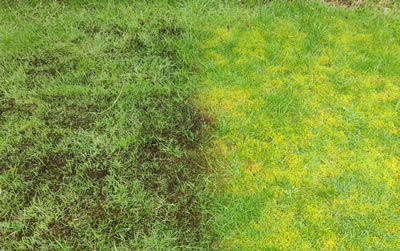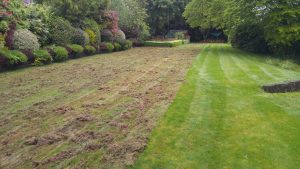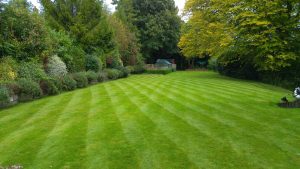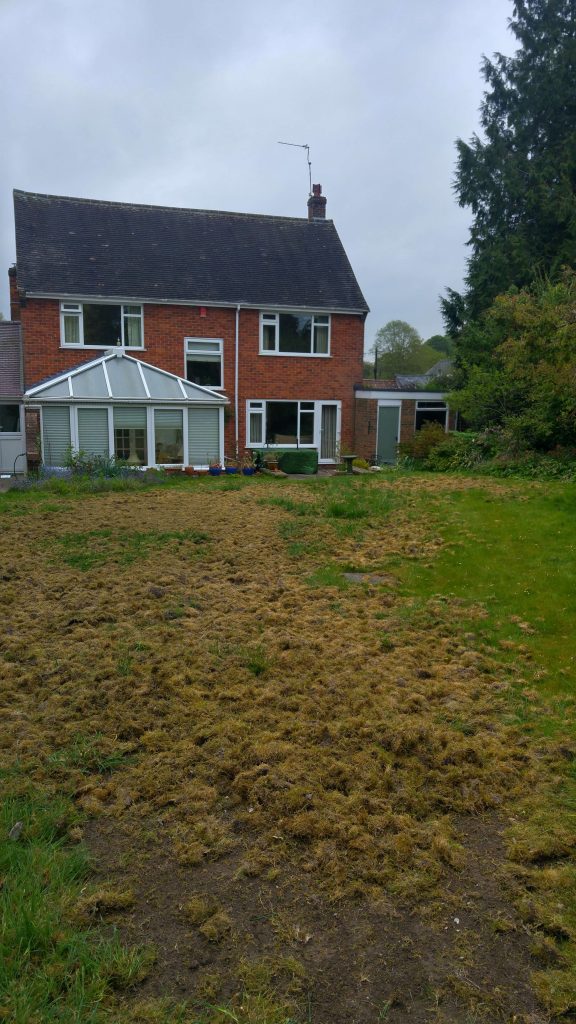Why remove moss from my lawn?
- Leaving moss un-checked can make it harder to mow your lawn as the mower becomes clogged or sink into the deep moss
- Excessive moss levels can prevent essential moisture, nutrition and oxygen from entering the soil
- Mossy lawns in poor condition suffer more from diseases such as Red-Thread and Fusarium Patch
- Moss dries out quickly in the summer leaving a bare lawn with unsightly brown patches where weeds can take hold
- Moss is relatively simple to control with specialist moss killers. If your lawn has developed moss issues get them under control before they become a major issue
What causes lawn moss?
What method will deal with moss in my lawn?
How can I prevent lawn moss?
Lawn moss briefly explained…
- Moss is more likely in lawns that are not receiving the correct treatment
- A shady garden or acidic lawn conditions encourages moss
- Moss is easily spread around your lawn by mowing too short
- Moss likes damp conditions – address drainage issues
- Treated moss – Untreated moss

Moss treatment before & after
What is lawn moss and where does it come from?
There are many types of moss found it lawns. Moss anchors in place with small hair-like structures and doesn’t have a root system like most other plants. Moss spore will settle on bare areas of soil and soon begin to colonise that area, spreading quickly in the right conditions. Moss can also be spread by cuttings. It’s essential that you never mow short enough to spread moss around your garden.
When is moss not a problem?
Moss is soft and spongy; it feels nice under-foot and is comfortable to walk or sit on. However, it really has no place in a garden lawn as it can cause major issues. Read on…
Why is lawn moss a problem?
Moss can quickly establish itself in a lawn if the conditions are right. It spreads rapidly and can quickly outcompete grass, starving it of light, moisture, and nutrition. As your lawn grasses die back the lawn soon becomes predominantly moss which can make mowing difficult. Moss has a high water content. In dry weather it soon turns brown, resulting in an unattractive lawn with bare areas, ideal for weed seed germination.
Lawn moss, pests, and diseases
Moss likes to retain moisture. Many lawn diseases such as fusarium patch, anthracnose, red-thread, and snow mould also like damp grass conditions. To avoid excess risk of lawn diseases it’s important that the lawn is well drained, and moss certainly doesn’t help with this. It is also thought that pests such as leatherjackets and chafer grubs prefer a mossy lawn.
Moss, nutrition, and drought problems
Moss acts like a sponge, soaking up and holding onto as much water as possible. This can prevent water from reaching the soil below and the root-zone of your lawn. Moss is more of a problem in lawns that don’t have the correct fertiliser plan in place to feed your turf and promote healthy grass growth. Poorly fed grass is less able to compete with moss. A thick layer of moss in your lawn is likely to make it harder for any applied fertiliser to reach your grass plants. Weaker grass is more likely in shady areas which will suffer more from disease, die-back and weed infestation.
Is lawn moss and thatch the same thing?
No, moss is a living plant and thatch is a layer of dead organic matter.
How do we deal with lawn moss?
Our Professional Lawn Treatment Plan includes the right nutrition to ensure turf grass growth is thick and healthy. Grass that is growing poorly and lacking the right feed is more likely to have bare patches which can create moss problems. We apply spray moss control treatments in the damp weather of autumn to slow moss growth and in early winter. This includes ferrous sulphate which is an effective moss killer. This will also help strengthen the grass and promote healthy, green lawns. After spray treatment with moss killer, remove moss with a rake or scarifier. Getting rid of the dead moss is advisable. In the spring grass seed can be added.
We advise our lawn care clients that poor drainage should be correctly managed and that it is always good practice to aerate lawns each year in the spring or autumn, especially if you have acidic soil where the chemical imbalance is related to more moss problems.
Get rid of shade problems by cutting back trees in the winter to allow in more light next spring. Shade is directly related to moss problems and lawns with garden shade from overhanging trees are likely to suffer in the autumn from leaf fall coving grass and causing more patches of moss growth over winter.
How to reduce moss in a lawn
- Deal with shade issues by cutting back overhanging shrubs and raising the canopy of garden trees
- Ensure your lawn is receiving the correct fertiliser programme to maintain healthy grass
- Never mow short into the moss layer in your lawn – this will spread it around more
- Scarify your lawn regularly to ‘power-rake’ out any moss before it becomes a problem
- Spray for moss with a liquid moss-inhibitor including iron during autumn and early winter. We also add a wetting agent to aid penetration into the plant
- Deal with compaction and drainage issues through annual aeration
- Improve soil structure by top-dressing your lawn which will also improve general turf health
How to remove moss and grow a healthy lawn
- Scarify or rake the lawn to remove as much moss as possible
- Aerate the lawn to improve soil drainage
- Treat the area with a liquid moss killer after you have scarified
- Ensure the grass is receiving the correct nutrition to aid recovery
- Over-seed the lawn regularly to fill in any areas of bare soil
- Remove moss by scarifying
- Lawns recover quickly from moss removal

Remove moss by scarifying

Lawns recover quickly from moss removal

 Established 2016
Established 2016




